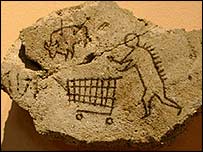I get challenged occasionally as to why a seemingly well-educated, presumably rational person would be interested in the paranormal. I'm always a little surprised by this question: Why not? Do we know everything? Isn't it rational and intelligent to assume we don't yet? Remember, a UFO is just unidentified, it's not necessarily from another planet. It's interesting to me that there are so many worth talking about, and the stories people tell about them are interesting in themselves. I'm certainly open to believing in many things, while being a strong skeptic about what counts as good data and strong argument.
Another really entertaining collection, equally amateur web-design but much easier to use: The Photo Galleries of Mystery from the MMMGroup. Truly, if you like archaeological mysteries, this is the place to browse. Make sure you hit page two, too. It might make you wonder about time travel... The phenomenon of OOPARTS, or Out of Place Artifacts, is a strong feature of the pictures of rock carvings (people with lightbulbs, space suits...) and fossilized items. Here's a blog post about this type of find with particular reference to a find in 19th century Massachusetts, a metal fossil apparently blasted out of solid rock.
On the other hand, sometimes these things are explicit funny fakes; here's a guy who briefly got away with rock art depicting a caveman pushing a shopping cart in a British Museum Exhibit (2005).

Banksy also hung a sign saying the cave art showed "early man venturing towards the out-of-town hunting grounds". It read: "This finely preserved example of primitive art dates from the Post-Catatonic era. The artist responsible is known to have created a substantial body of work across South East of England under the moniker Banksymus Maximus but little else is known about him. Most art of this type has unfortunately not survived. The majority is destroyed by zealous municipal officials who fail to recognise the artistic merit and historical value of daubing on walls."
1 comment :
On the subject of weird US defense research, Jon Ronson's book "The men who stare at goats" is a good, fun read.
Post a Comment